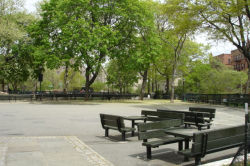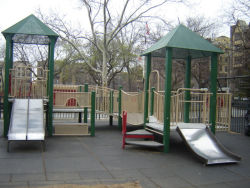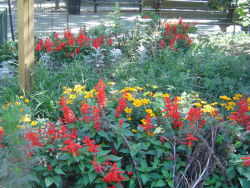Bennett Park
Bennett Park
Bennett Park occupies the highest point of land in Manhattan, 265.05 feet above sea level. A large outcropping of Manhattan schist dominates the center of the park. The area was part of a densely wooded hill known as Penadnik to the Delaware Munsee Indians. Early Dutch settlers called this part of northern Manhattan “Long Hill” and found the land useful for lumbering.
During the Revolutionary War, General George Washington located his base of operations at this strategic high point, and established a similar fortification across the Hudson in Fort Lee, so he might gain control over river traffic. Fort Washington was built in 1776 and was the last stronghold for the Americans as the battle for New York swept northward on Manhattan Island. On November 16, British and Hessian troops swiftly attacked and seized Fort Washington in a pivotal defeat for the Americans. After the war, vestiges of the Fort disappeared, and the surrounding area became known as Washington Heights. At the south end of the park bluestone and granite paving outline the contours of the eastern section of Fort Washington.
In 1871 the land that is now the park was purchased by James Gordon Bennett (1795-1872), the prominent newspaper publisher and editor who is widely recognized as a pioneer of American popular journalism. Born in Keith, Scotland, Bennett emigrated to Nova Scotia in 1819 and settled in New York City four years later. He worked as the Washington correspondent for the New York Enquirer in 1827-28 and became associate editor for the Courier and Enquirer in 1829.
Bennett launched the New York Herald in 1835, assuming the responsibilities of editor, reporter, proof-reader, folder, and cashier. Because of his independent and opinionated style, Bennett was lambasted in other publications and was physically assaulted by two of the targets of his critical pen. Nevertheless, the newspaper’s coverage of finance and politics, crime and scandal, and national and international news, along with Bennett’s bold and often controversial editorials, made the Herald one of the most successful daily newspapers in the United States. Bennett retired in 1867 but continued to write for the Herald until he died on June 1, 1872. A massive memorial to him stands in Herald Square.
In 1901 his son, James G. Bennett Jr., permitted the Sons of the American Revolution to erect a monument on his land to commemorate the Battle of Fort Washington. Designed by Charles R. Lamb, this ornate marble and granite stele with bronze detailing is located on the eastern perimeter wall of the park. A historic cannon once stood on the terrace overhanging this monument.
Although he was said to have intended to donate the property for a park, the younger Bennett died in 1918 without putting it in his will. Consequently, the property was divided for sale, while honoring the request of the American Scenic and Historic Preservation Society to preserve that portion of the land where Fort Washington once stood. In 1928 the City of New York acquired the site of the fort and additional land and assigned the property to Parks.
Bennett Park opened in 1929, and three years later the Washington Heights Honor Grove Association planted an American Elm tree in the park to commemorate the bicentennial of George Washington’s birth. A playground was constructed in the 1940s, and the brick public restroom and storage building was erected in the north part of the park in 1964. For the 200th anniversary of the Battle of Fort Washington in 1976, the Washington Heights-Inwood Historical Society re-enacted the conflict on the site of the former fort in Bennett Park. A neighborhood treasure, this historically significant park offers visitors a place for quiet recreation.
In 1996 a bronze plaque set in marble was dedicated at the park's southeast corner in memory of Private First Class Emilio Barbosa (1926-1945), a United States Marine enlisted in World War II. On March 27, 1945, Private Barbosa was manning a gun turret aboard the battleship USS Nevada at Okinawa Shima. As a Japanese Kamikaze plane attacked his ship, Barbosa fired and disabled the enemy aircraft. The plane plunged onto the deck of the battleship, and the bomb carried by the plane blew up on impact. The explosion mortally wounded 11 marines, including Barbosa, and injured 95 others. A gift to the City by the soldier’s brother, the Barbosa monument honors the young hero who grew up on nearby Pinehurst Avenue.
In 2000 the playground was renovated, and in 2005 the Citywide Monuments Conservation Program restored the Fort Washington Monument. A major park renovation was completed in 2012. The intent of this project was to provide improved access around the Manhattan summit rock outcropping, to restore the lawn for passive uses, to enhance the southern plaza to facilitate children's recreation and to improve the delineation of the old fort outline. The Barbosa plaque was moved and reset within a rustic boulder near the central playground, and the missing Washington bi-centennial tree marker replicated. A replica of a Revolutionary War-era double tail six-pound English field cannon was introduced as a symbolic artifact that resonates with the site's historic origins.
Check out your park's Vital Signs
Clean & Safe
Green & Resilient
Empowered & Engaged Users
Share your feedback or learn more about how this park is part of a
Vital Park System



